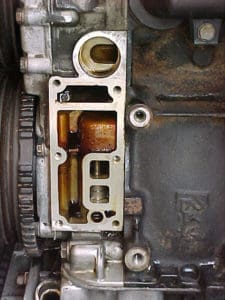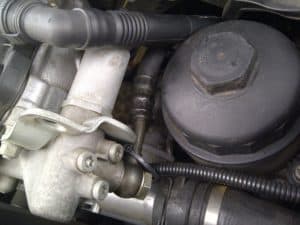BMW E36 Oil Leaks
BMW engines aren’t known for leaky gaskets or premature failure. However, just like any other engine they do have their faults, and gaskets that are more leak prone than others. The E36 Series has a few extremely common sources of oil leakage, especially in higher mileage vehicles. This article will discuss the most common sources of oil leaks, how to diagnose, difficulty/cost of repair, and how to best extend the life of the various gaskets on your motor so they don’t leak.
Valve Cover Gasket

By far the most common area of oil leakage on any E36 is the valve cover gasket. These gaskets commonly dry-out over time, and are frequently basically plastic on removal. Really bad valve cover gaskets can leak onto the exhaust manifold and cause black smoke to rise from the engine bay.
If you do notice an oil leak, check the valve cover when the engine is cold. To do this, run your finger right below where the valve cover and head mate toward the rear of the car. If you notice any fresh oil you’ve definitely got a leak.
Another really obvious sign is if you are changing the spark plugs and you notice that the spark plug wells are filled with oil. There are spark plug tube seals that come with a new valve cover gasket, and they turn to plastic just the same as the outer gasket.
Valve cover gaskets are relatively inexpensive and quick to replace. On a four-cylinder E36 the job is quite easy, on an inline six the job is a little more involved but quite doable. I usually change the six-cylinder gaskets within an hour and a half.
I usually go with Mahle for E36 valve cover gaskets, which you can get here.
VANOS
The Vanos solenoid and the Vanos oil hose are notorious for leaking. Actually, I believe the oil line is the main source of an oil leak in my 328i right now, as I can see quite a bit of oil directly below the line.
The Vanos is hydraulically operated on a pressurized system, and over time the oil feed line begins weeping oil. The solenoid actuates a valve to allow oil to enter the Vanos. Overtime the solenoid O-ring gasket can go bad and cause a leak that appears very similar to the oil hose leak.
Vanos leaks are relatively easy to diagnose as you can see the hose and solenoid quite well simply by opening the hood. That’s where the easy part ends unfortunately. Officially, you need to remove the intake manifold in order to gain enough clearance to replace the Vanos feed hose. However, I believe there is just enough room for someone with small hands to replace the oil line.
I have decided not to attempt this, and to instead remove the intake manifold. The reason for this is that I also have a large vacuum leak coming from the manifold gasket. Removing the intake manifold will allow me to kill two birds with one stone.
The parts to fix this leak are very cheap, however if you have to pay a mechanic to remove the intake manifold, this job will cost significantly more than a valve cover gasket replacement.
You can get the Vanos Oil Line here. I actually bought the same one from URO and it held up pretty well!
Oil Filter Housing Gasket

This is one that often gets overlooked prior to scouring the bimerforums or taking the car to a mechanic, but it’s pretty common for higher mileage BMW’s, especially seeing that most e36s are at least 22 years old now!
Something very noticeable about this gasket is that when it goes bad it leaks significantly more oil than the valve cover gasket. This is because the oil in the housing is pressurized, unlike the valve cover where the oil will simply leak because of gravity.
Replacing the housing gasket is a somewhat involved process, but can certainly be done. You need to remove the main serpentine belt, and then remove the alternator. Afterward you need to loosen the power steering pump to get just enough clearance to remove the filter housing.
There is no need to open or remove parts of the power steering system. Simply remove the two small bolts holding the power steering reservoir to the filter housing and leave it hanging. Definitely a nasty job, try and drain the housing as best as possible so you don’t end up repainting your clothes with oil.
CCV Valve

This is probably the most common source of oil leaks after the valve cover gasket. It is highly recommended to replace this valve as part of your preventive maintenance every 100-120,000 miles. This valve recirculates the oil in your engine, and depending on how it goes bad it can burn off quite a bit of oil in a short amount of time.
Symptoms of a bad CCV are blue smoke from the exhaust, high oil consumption, and a very strong vacuum in the valve cover. You may also hear the CCV making a loud noise, it is located directly underneath the intake manifold.
Luckily these valves typically cost around $100 and can be replaced without having to remove the intake manifold. I replaced this valve a few weeks ago on my e36 and it took about an hour.
Miscellaneous Leaks
The four listed above are typically your most common sources of oil leaks, however there are other gaskets, o-rings, and areas where oil can leak from on your vehicle.
An oil pan drain bolt leak is common when the bolt and washer is used for to many oil changes. The bolt and washer are made to be replaced at every oil change, however many diyers will use the same bolt and washer for several at a time. The bolts are made in a specific way so if they fail they will snap to avoid damaging the pan. Another possibility is that the oil bolt was overtorqued, this would also cause an oil leak.
Oil pan gasket and main shaft seal leaks are less common sources, but they can and will leak on high mileage vehicles.
The main shaft seal is located on the center of the engine, behind the crankshaft pulley. If you have a leak coming from this seal, simply shine a light behind the crankshaft pulley and you will see the oily mess.
The oil pan gasket is a nightmare to replace, and most owners are happy to have a small oil leak rather than get into an involved process like replacing the oil pan gasket. For those brave few who want to or decide to have a mechanic replace it, the process is extremely involved. You pretty much need to remove the entire front suspension on a bmw e36 to remove the oil pan. You need to support the engine since you have to remove the engine mounts, and you need to remove the steering rack. Not my cup of tea.
Tips to Reduce the Frequency of Oil Leaks
To many people use cheap quality oil to save a few bucks or assume that the really good stuff isn’t actually any better. This is bologna, always go with the recommended weight or close to it, and stick away from cheap generic brand oil. What brands should you be looking for? Mobil 1, Royal Purple, and Castrol, and nothing else.
Another cause of premature oil leaks is waiting way to long to change your oil. BMW’s recommended interval of 12 – 15k is way too long. I change mine every 5 – 7k, and my 328i loves me for it. Excessively late oil changes results in excess wear on the engine.
Keep your coolant system in good shape as well! Excessive heat due to coolant system failure also causes wear on the engine, and can certainly cause an oil leak.
Conclusion
If you notice that you’re losing more oil than you used to, one of these sources of leaks may very well be your cause. If you’ve simply noticed drops of oily looking substance under your car in the garage, don’t assume it’s an oil leak.
A coolant leak can sometimes look like oil or power steering fluid by the time it travels to the ground. There are also several more common sources of fluid leaks besides oil that I didn’t mention.
Power Steering is one of those leaks that you think you can fix 100%, but you never really can. You can literally replace your entire power steering system, and within six months you will have another small leak coming from your hoses.
I hope this article was helpful in getting an idea of where your leak is and how to replace it, check out my blog for more helpful articles!

